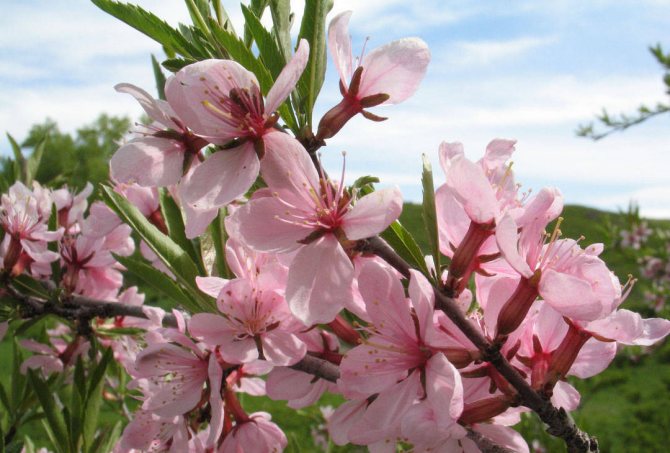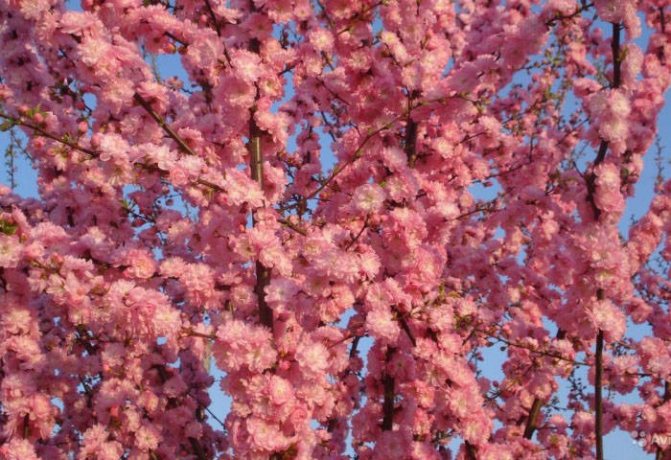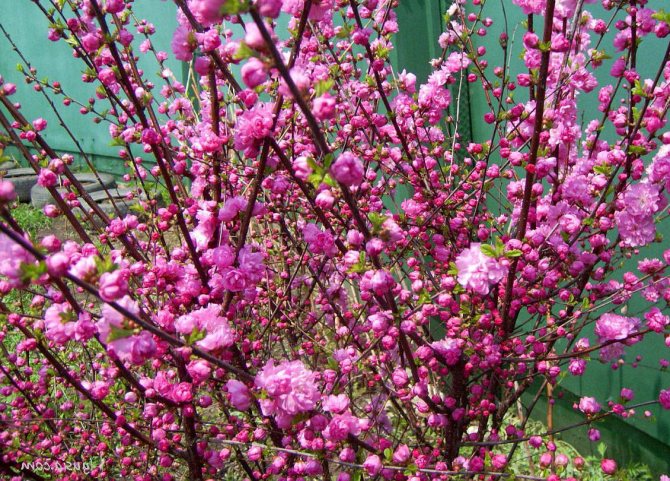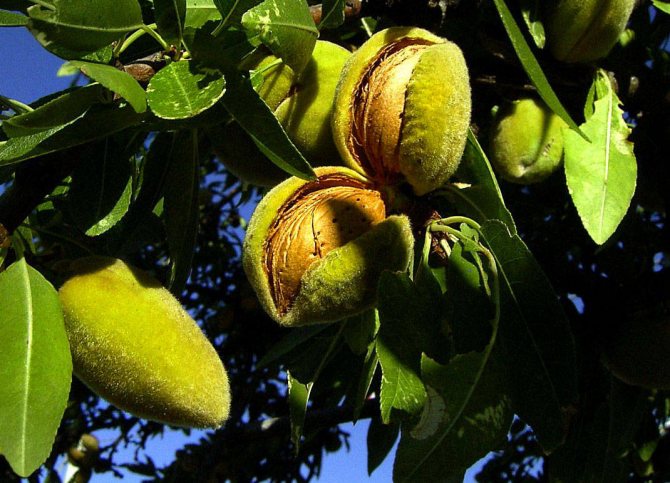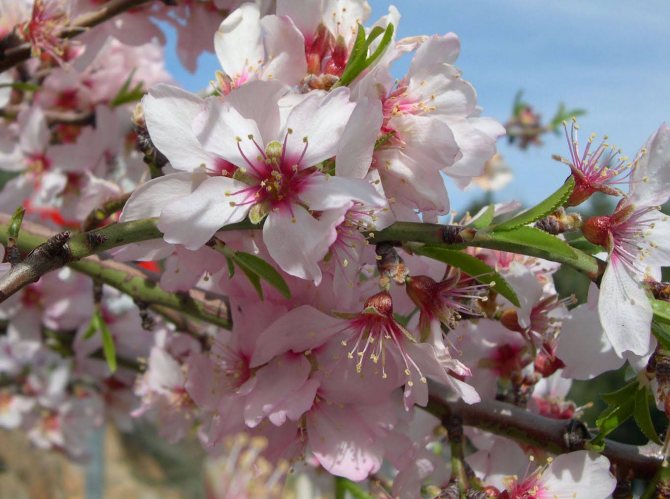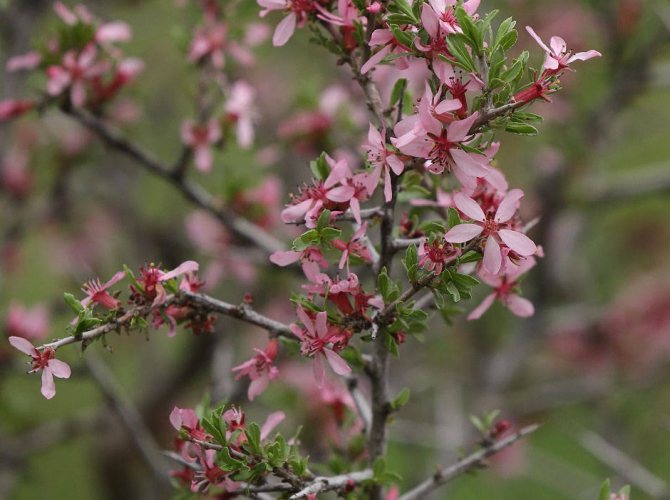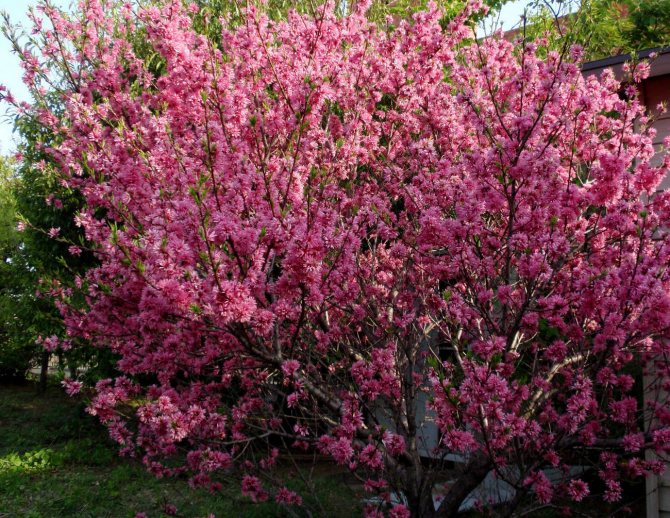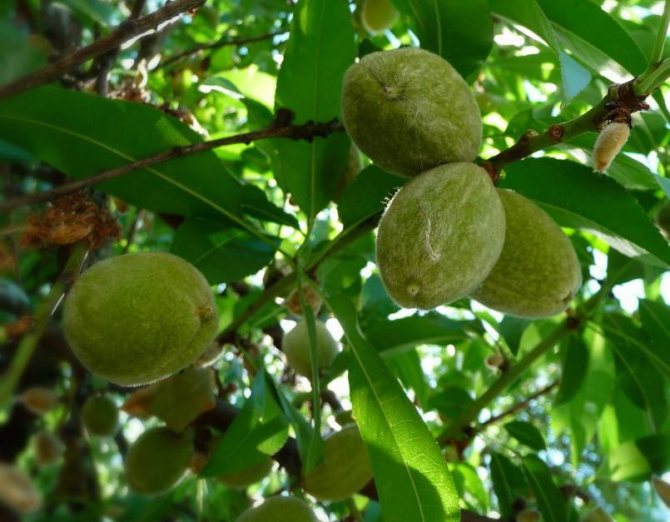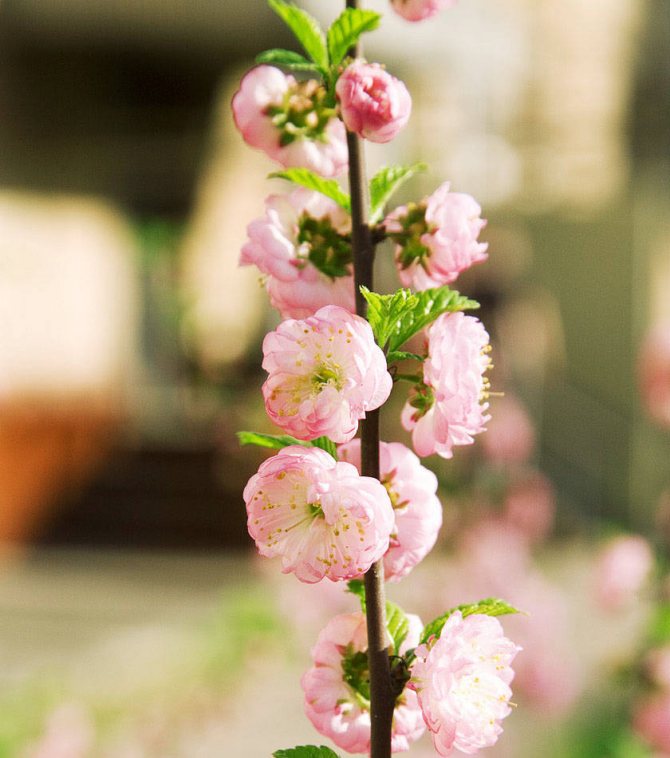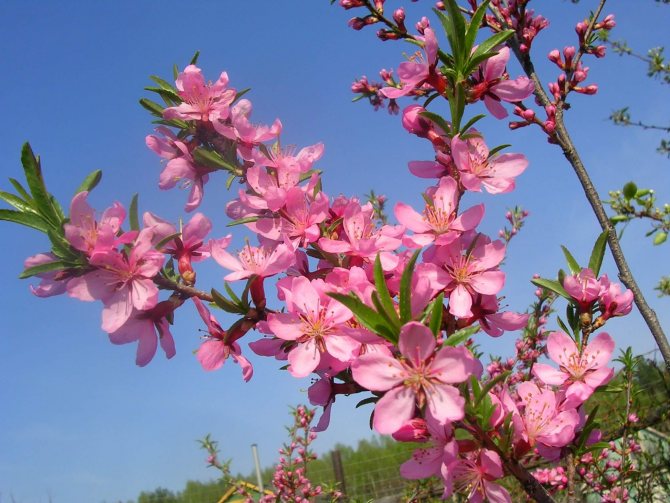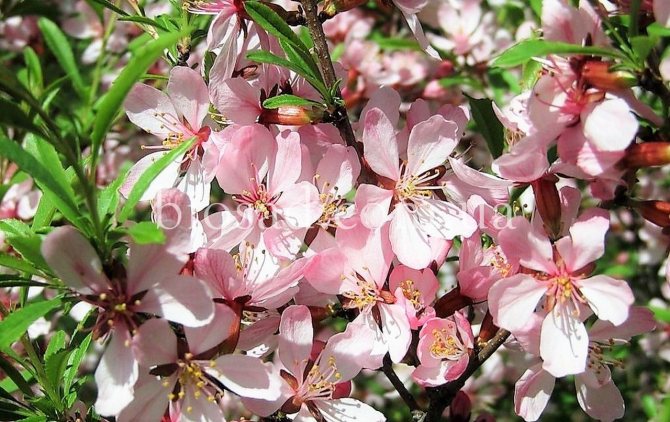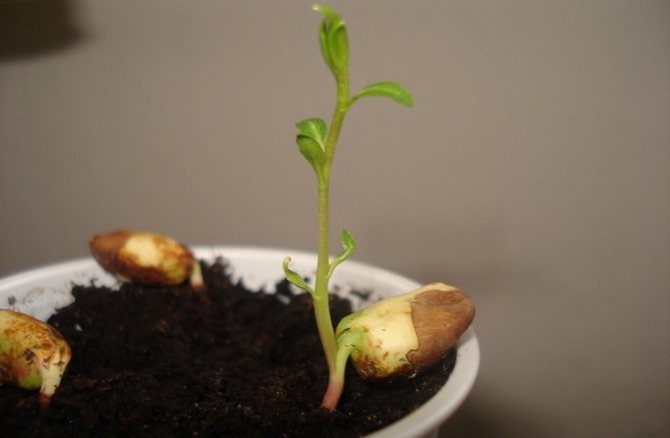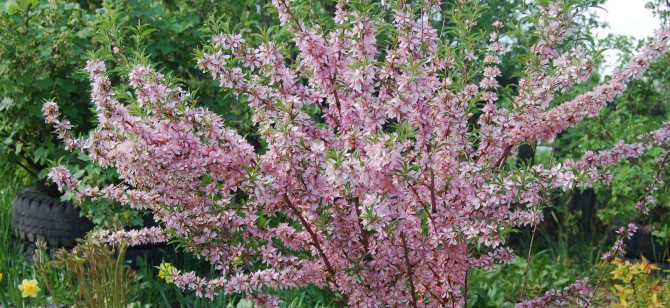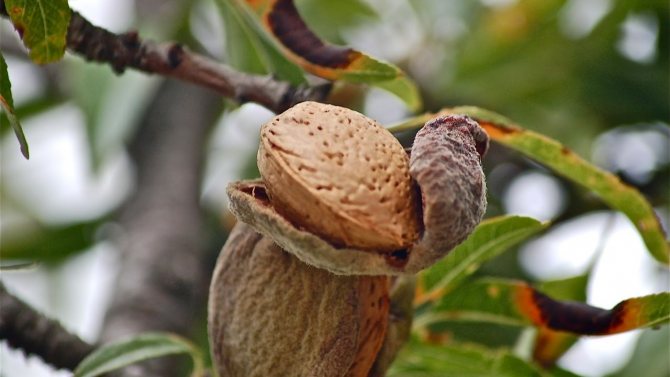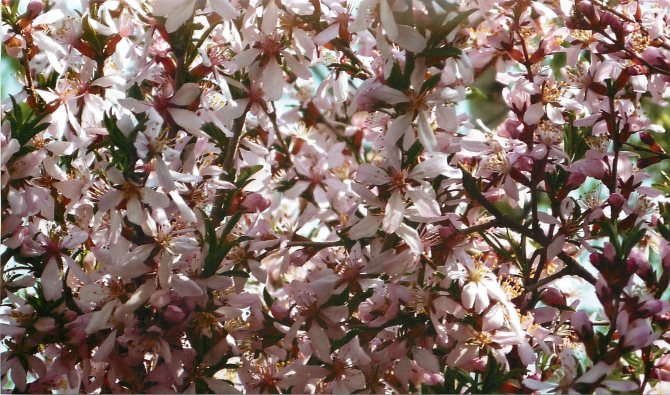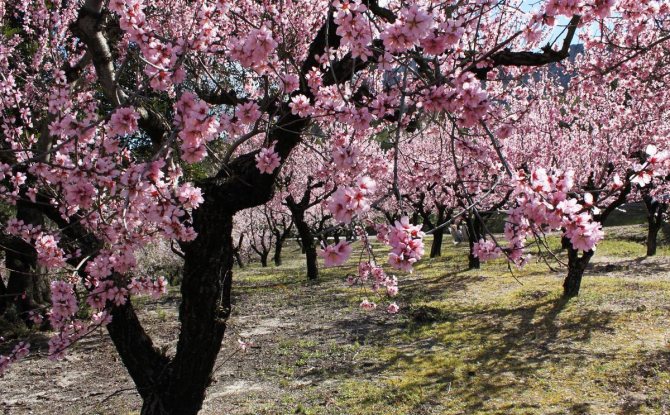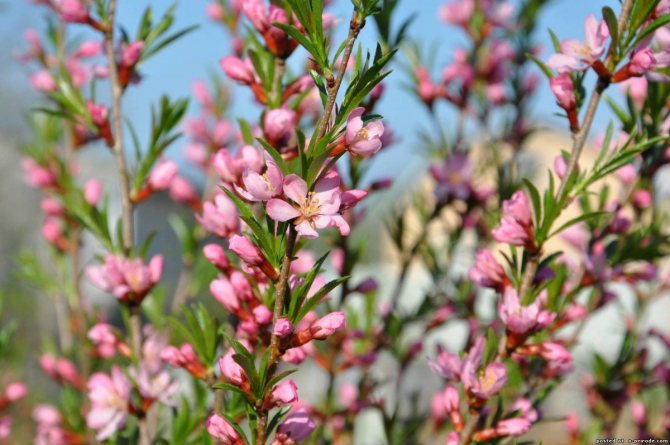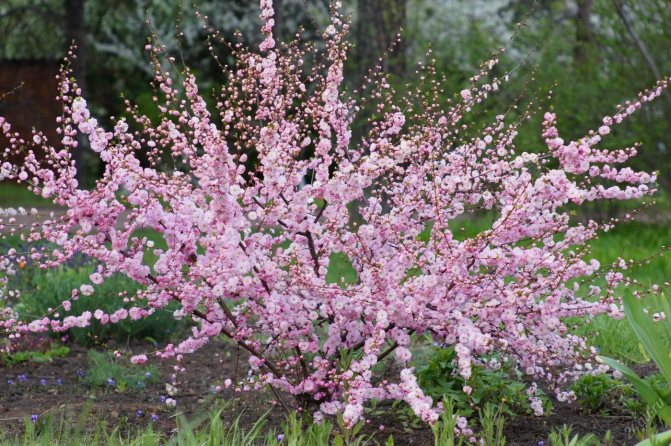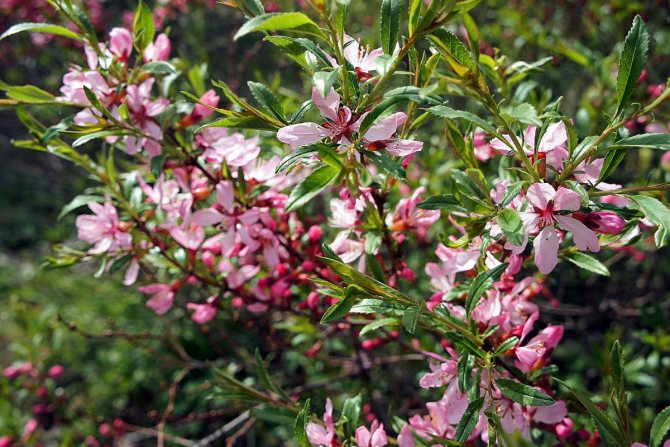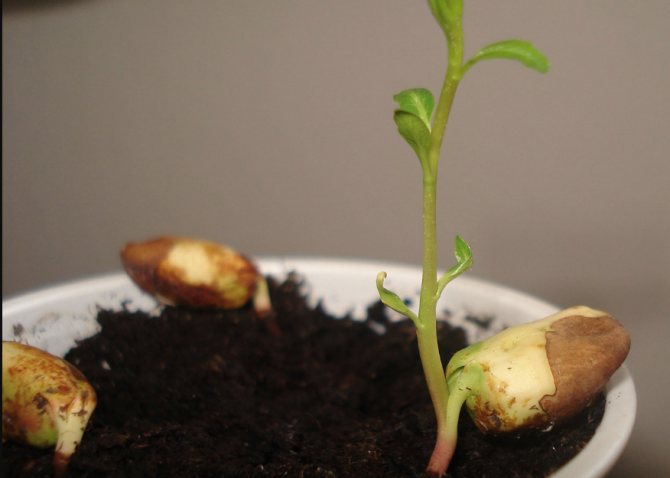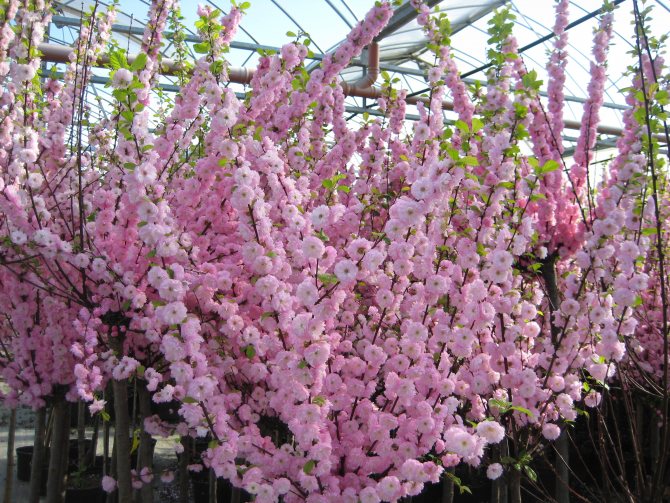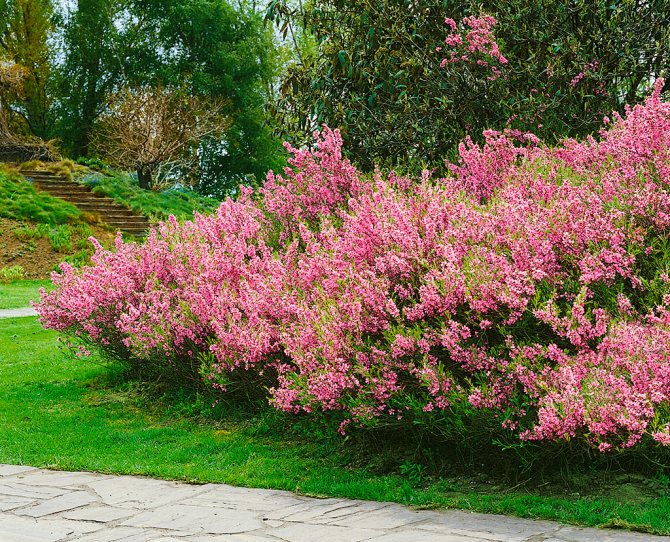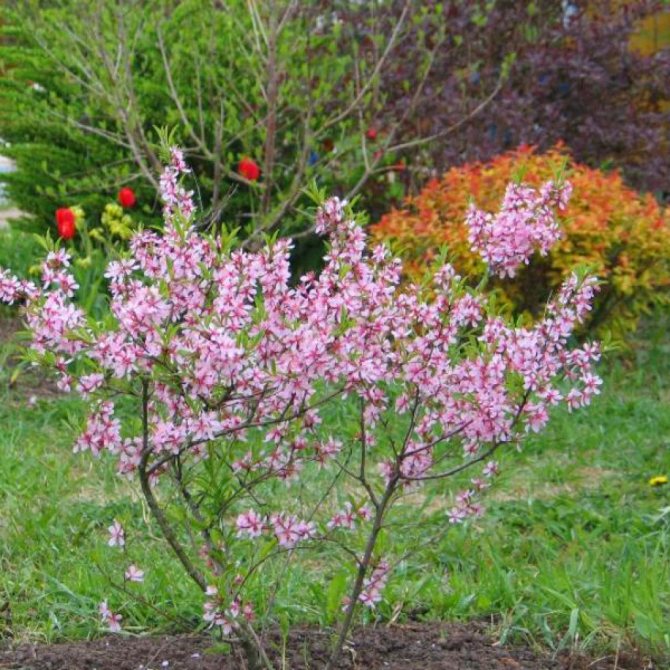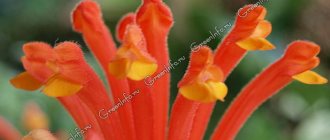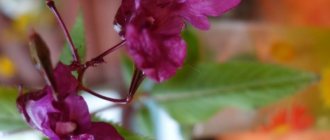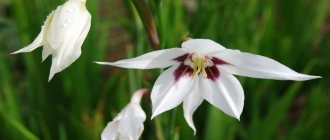Many have seen how almonds, a shrub, are strewn with a delicate pink-white color in spring, planting and caring for which does not cause much concern to gardeners. This marvelous, low deciduous plant can transform any garden with its abundant flowering and decorate even the most unsightly corner. Most of its varieties are light-loving, frost-resistant, perfectly tolerant of drought and infertile soils. In the wild, it grows in the south, in the middle zones of Siberia, Crimea, the Caucasus, Central Asia, Belarus, Ukraine, both singly and in small groups. In cities and summer cottages, the shrub is an excellent honey plant, a valuable hedge that can last up to 130 years.
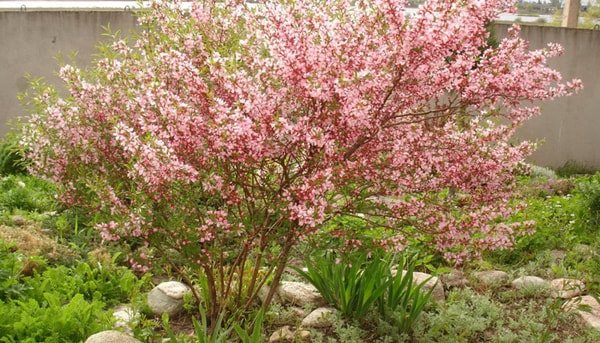
general description
All modern ornamental almond varieties, small trees or shrubs, come from East Asia; in North Korea and China, the plant is still found in the wild today. This closest relative of plum, quince and rose hips, during the flowering period, is covered with spectacular flowers in a predominantly pink range, acquiring an unusually picturesque look. Thanks to this feature, almonds have become one of the most sought-after garden plants around the world; The almond tree can be described in the following facts:
- Spread
... The plant came to Europe a couple of centuries ago, but it was only grown in Russia in the 20th century. Today, almonds can be seen in Europe, Central Asia, and America.
- Diversity
... There are many varieties of this elegant plant. Depending on the variety, it can look like a large bush two to three meters high or a tree with strong branching, reaching five meters in height.


Young plant
- Appearance
... During flowering (which lasts 2-3 weeks), the branches are covered with numerous pink flowers; simple or double flowers create the impression of a lush cloud and give the plant an extraordinary decorative effect. After flowering, almonds retain their attractiveness due to the compact and spherical shape of the crown; the fruits of the ornamental plant are inedible.
- Almonds in landscape design
found the most widespread use. It is planted as a lonely plant or made the center of the composition; sometimes planted in a hedge.
- Properties
... The almond tree, despite its origin, is a very unpretentious crop. In the wild, it can be found in the Caucasus and Western Siberia, in the European part of Russia - in summer cottages and garden plots. The shrub has a fairly high frost resistance (up to 20-25 ° C frost) and drought resistance (which, nevertheless, should not be overestimated).
- Improving decorativeness
... For the flowering to be spectacular, the branches must be pruned every year; otherwise, they will stretch out strongly.


Blooming Beam Source
Diseases and pests
Leaves and shoots of an ornamental shrub are susceptible to fungal diseases:
- gray rot;
- rust;
- moniliosis;
- scab;
- clotterosporium disease.
In the presence of symptoms of the disease - brown spots and dots on the leaves, the dying off of the tops, almond bushes are treated with fungicides:
- Cuproxat;
- Fundazol;
- Speed;
- Topaz.
Harm the leaves and fruits of ornamental shrubs:
- almond seed-eater;
- leaf roll;
- aphid;
- spider mite.
Acaricides are used against the latter pests:
- Agravertine;
- Akarin;
- Kleschevite.
Insects are fought with effective insecticides:
- Zolon;
- Fufanon;
- Calypso and others.
Variety selection
Although, compared to other shrubs, almonds do not require much maintenance, when choosing a variety, the climatic conditions of the garden (the frequency of rains and the quality of the soil) should be evaluated. If the terrain where the site is located is too dry, the tree may have difficulty adapting. In the middle lane, the following varieties of almonds can be cultivated:
- Steppe decorative
... Other names for this plant are also common - bean or low almond. The shrub reaches one and a half meters in height and blooms for a short period - you can enjoy the white-pink cloud for no more than 7-10 days. Two forms of the plant are known, one with white flowers. A pleasant feature of the plant is fragrant flowers and edible fruits.
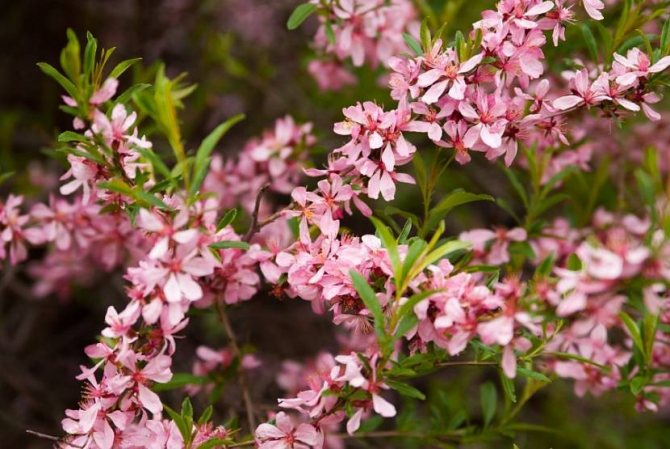

Bobovnik
On our website you can find contacts of construction companies that offer landscape works. You can communicate directly with representatives by visiting the Low-Rise Country exhibition of houses.
- Bean varieties
... Popular varieties suitable for breeding in the temperate zone with cold winters include Pink Flamingos with an early flowering period, Pink Mist, Anyuta, Dream and the drought-resistant White Sail. For all varieties, the choice of planting site is important. If you want to prolong flowering as much as possible, then the place for the plant is chosen in partial shade. If the main thing for you is the splendor of the flowering, plant the plant in a sunny area.
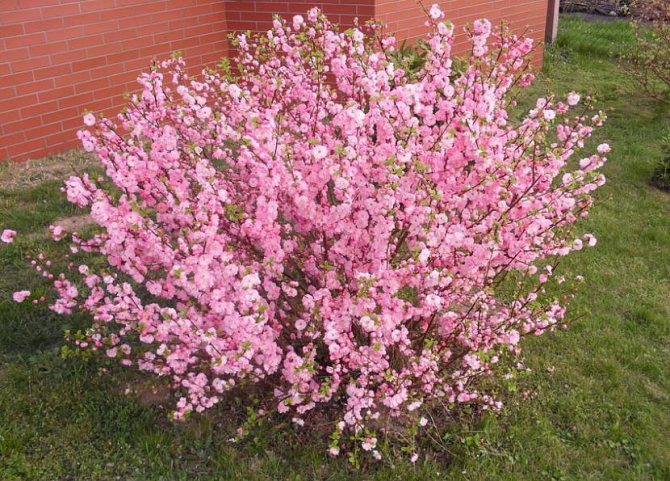

- Three-lobed almond
(Prúnus tríloba). One of the hybrid varieties, the second official name of which is three-bladed luizeania, and the folk name is sakura near Moscow (option: Japanese cherry or Chinese terry plum). The variety got its name because of the characteristic (three-lobed) shape of the leaves. The almond tree grows especially well in sunny areas, but does not like strong winds. Flowers bloom in mid-May, they can have different color saturations, from pale pink to deep crimson.


Luiseania Source
- Georgian almonds
... The bush outwardly resembles the steppe variety, but has slightly larger leaves; distribution area - wooded slopes of the Caucasian mountains. The plant reaches a height of 1-1.5 m and has a developed root system. During flowering, the branches are covered with a bright pink color. Fruits ripen by mid-September and only on plants that have reached seven to nine years of age. The variety is valued among amateur gardeners for its special unpretentiousness: resistance to the vagaries of the weather, diseases and pests.


Georgian almonds
- Almond Petunnikov
... This type of shrub is native to the stony uplands of Central Asia, which determined its appearance: Almond bushes with grayish bark and elongated leaves rarely reach a height of 1 m and a crown diameter of 0.8-1 m.At home in the wild, the plant forms dense almonds, in Russian dachas, you can often see individual plants. A special charm to the shrub during flowering is given by single flowers of a rich pink tone; fruits appear in the sixth year.
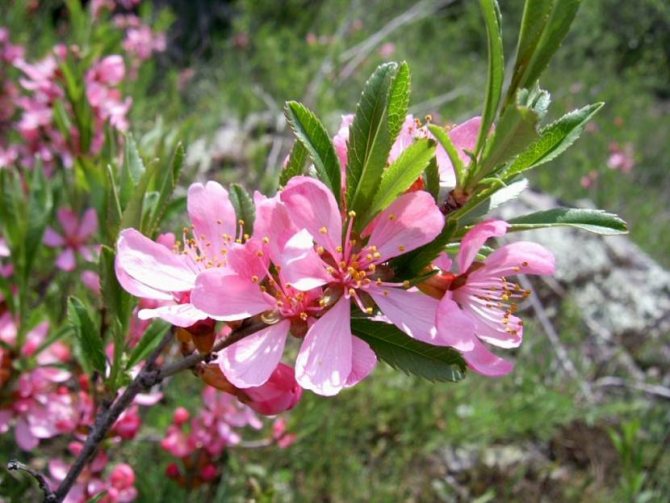

Variety Petunnikov Source
On our site you can find contacts of construction companies that offer the service of building small architectural forms. You can communicate directly with representatives by visiting the exhibition of houses.
- Ledebour almond
... The homeland of the Ledebour variety is the Altai foothills and plains, where you can still find thickets of almond bushes in the wild. One of the most popular, despite its dwarfism (1 m), varieties among gardeners. Its value lies in early flowering and general unpretentiousness.The variety blooms in early May, bright pink splendor adorns the surrounding landscape for two to three weeks; begins to bear fruit in 9-10 years, but there is no need to expect special harvests from it. Attention is drawn to a variety of shrubs, the Fire Hill variety, with large, up to three centimeters in diameter, deep pink flowers.


Ledebour variety Source ecokadastr.kz
- Snows of Wimura
... A widespread hybrid variety, large double inflorescences of which, during flowering, change color from the original pink to cream.
- Ruslana
... A hybrid of a three-lobed almond, also known for its ability to change color. Initially, its flowers are colored beige, but eventually become snow-white.
Almonds in landscape design
Many experienced gardeners choose almonds as a decorative decoration for their local area because of its unusually beautiful flowering.... The shrub is often planted on lawn grass, slopes, or near garden stones. The well-thought-out shape of the crown can shade places for rest or, in the case of planting a large number of bushes, form a beautiful promenade.
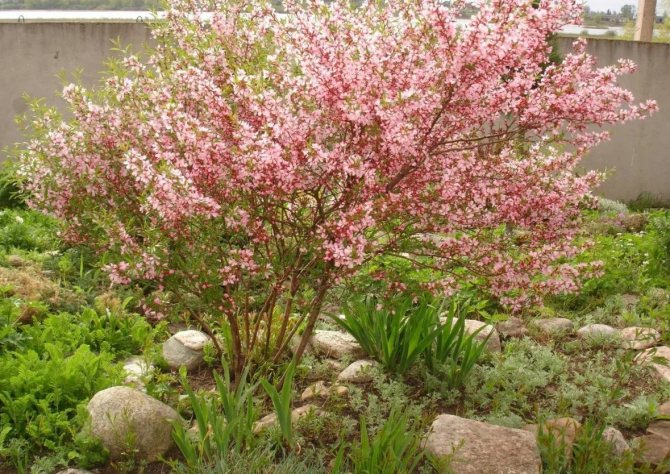

Bush formation
The crown of a mature ornamental bush is pruned like a peach tree in several stages every year:
- At the beginning of spring, the first sanitary pruning takes place.
- After a violent flowering, branches are removed that were too active. This helps the trunks to ripen and direct forces to the formation of young shoots.
- Then they often give the necessary outlines: they create a bole up to 55–70 cm in height, and 5–7 branches are left on the main trunk.
- In the summer season, all processes that go beyond the boundaries of the form are pinched. Also, a planned pruning of branches that have grown over 60 cm is carried out.
Did you know? Bitter almonds contain a large amount of a poison called amygdalin glycoside, which gives the product a specific taste. That's why
the fruits of the bush cannot be eaten without special treatment (a lethal dose of bitter nuts
—
50 pieces).
Tree formation
The creation of a crown consists of the following steps:
- It is necessary to decide on the height of the trunk: choose the one with which young branches should begin their growth. All other lower shoots must be cut to zero.
- Next, you need to select the skeletal branch. Its role will be performed by the maximum height shoot from the bottom row. It should be very strong and fully formed.
- The near branch, which is located at a height of 15 - 20 cm from the main skeletal branch and looks in the opposite direction from it, will become the second skeletal one.
- The third skeletal branch should be 15 - 20 cm higher than the second and look perpendicular to the above shoots.
- Without exception, all branches that grow in the area of the three skeletal ones are cut to zero.
- Controlling the main trunk will help regulate the upward growth of the tree. It should be 0.5 m higher than the last branch.
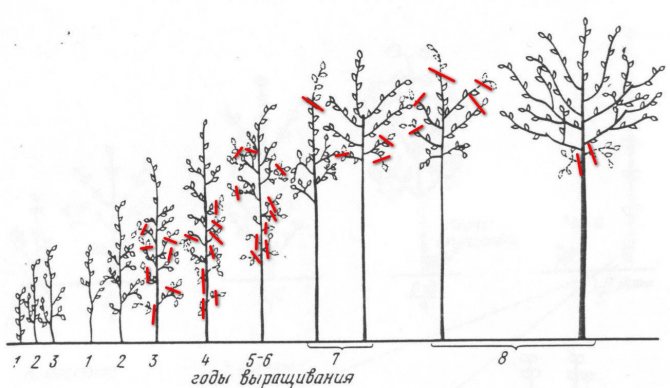

After pruning, you need to monitor the growth of young shoots.... They should not thicken the crown and dominate skeletal branches. Excess shoots that are knocked out of the general shape of the shrub are corrected by pruning. Cutting off dense branches, it is necessary to blot the cuts with a garden broth to heal cuts and wounds (a talker made of 200 g of clay, 100 g of manure and 100 g of lime, diluted with water to a state resembling thick sour cream, will do). This will stimulate the rapid regeneration of the tree.
Learn also about varietal almond trees.
Almonds on a trunk


Stamped almonds look just as impressive as a bushy garden plant. A seedling of the desired shape can be purchased ready-made from specialized specialists or created by yourself... Moreover, this is quite simple to do. The easiest method to form a stem is to trim the crown to help create the stem.The procedure takes a lot of time, but it is very effective.
The formation of a trunk can be carried out by tying an even seedling (always without knots) to a standing wooden support immediately after transplanting to a prepared area. After the bush has passed into the stage of active growth, the top must be tied to a hammered peg, and all side branches must be cut off. This will give the bush the shape of a hat.
The bright and distinctive decorative almond is resistant to extreme heat and cold winters. With proper care, it will delight the eye with spectacular flowering for a long time: the culture can grow on a site for up to 100 years. Due to the variety of options for forming the crown, you can easily complement the landscape design of your garden with an original and unpretentious plant.
Landing
A gardener who decides to decorate his site with an almond tree must provide the following conditions for the well-being of the plant:
- Illumination
... All varieties love sun and air. If you cannot provide a permanent place in the sun, plant the plant so that the shadow falls on it for no more than 3-4 hours a day.
- Wind
... In order for the tree to develop well and delight you with its lush color, take care of protection from the winds prevailing in the area; it can be a fence, slope or structure.
- The soil
... The best option for almonds is sandy or rocky soil with good drainage capacity. If the soil is clayey on your site, it will have to be limed.
- Stagnant water
... A place where the soil is periodically heated is not suitable for the root system of almonds - it may die.
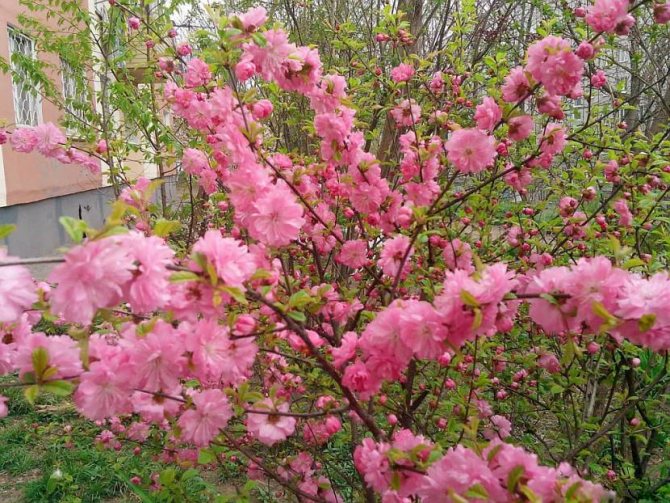

Terry almond (three-lobed Rosenmund) Source
This might be interesting!
In the article at the following link, read about a decorative garden crane.
Planting of almonds can be done by seedlings or seeds, and is determined by the plant variety. Planting with seedlings has become more widespread; this method is attractive with a quick result: you will be able to admire the flowering already in the second year. A gardener who decides to plant several plants should take into account the following rules:
- Boarding time
... It is customary to plant decorative almonds in the fall, always fertilizing the soil. This will help the seedlings adapt to the gradual decrease in temperature and survive the winter without any problems.
- The importance of cross-pollination
... If you do not take care of the conditions for this important process, almonds will not bloom. For pollination to take place, trees are planted close to each other; the optimal distance between seedlings is at least 3 m. At the bottom of each pit, a cushion of rubble and sand is arranged.
- Watering
... Since the plant is drought tolerant, one watering per week will be sufficient in most cases.
Reproduction
The method of propagation of decorative almonds depends on its shape. Species plants are sown with seeds, and varietal plants are sown only by cuttings, layering, shoots or grafting. Amateurs often grow their own rootstocks from seeds, and then take out cuttings of the variety they like for engraftment. Almond seed fruits are sown in the fall in a school. In the spring they sprout. On rising shoots 1 cm thick from below, up to 10 cm in height, all branches are removed on the ring. Plants are transplanted in the fall. Next year they can already serve as stock. Almonds are planted in spring and August.
Easy ways to propagate decorative almonds - layering and shoots. Root suckers grow after heavy pruning. They are dug up in the fall a year later, when a separate root system is formed. The lower branches of varietal decorative almonds are added dropwise in the spring, leaving the top. The shoots are transplanted in the fall, after a year.
Ornamental almond cuttings are cut after June 15 from semi-lignified tops. The length of the segments is up to 20 cm, each should have 2 knots.Cuttings with a lower cut are placed in a growth stimulator according to the instructions, then they are planted in a light substrate of peat and sand so that 1 node remains above the surface. Sections of almond twigs take root in a month, in the fall they are transplanted into a school, carefully mulched and covered.
Features of agricultural technology
Almonds, belonging to the genus of ornamental plum, take root well on moderately fertile soils if planted in a sunny place with desirable drainage. In order for the plant to develop well and bloom, additional care is required, which consists (in addition to watering, feeding and loosening) in the following actions:
- Pruning
... The procedure has two purposes: it forms the crown and is the prevention of diseases. If you do not prune, the decorativeness of the plant decreases, and you will not wait for a lush color. Sanitary pruning helps in getting rid of potentially dangerous dry and mold-damaged branches. Decorative pruning thinns the crown, removing branches that interfere with each other and grow inward. For healing, after the end of flowering, the branches are shortened by 2/3 of the length; such an operation stimulates the growth of new, healthy shoots.


Pruning Dry Branches Source
- Wintering
... During cold winters, frost can damage the buds and excess snow will damage the base of the trunk. To protect young almonds from problems, the base is covered with straw, and the branches are carefully wrapped with covering material (for example, lutrasil).
- Inspection as disease prevention and pest control
... Most often, almonds can become a victim of aphids, which suck out juices, or caterpillars, which leave branches without leaves in a short time. The larvae of the May beetle are also dangerous, capable of irrevocably destroying the root system. Bush disease can be caused by a fungus, a virus, or unfavorable environmental conditions. To eliminate problems, there is a wide range of chemicals, sometimes natural remedies are effective (for example, ladybugs are happy to include aphids in their diet).
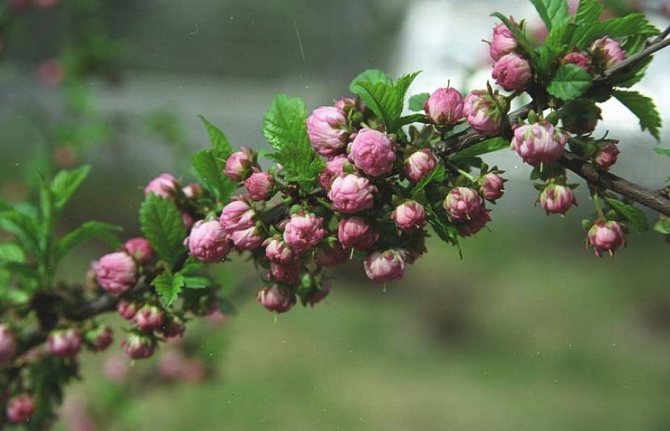

This might be interesting!
In the article at the following link, read about James Bond's Invisible Garage.
Wintering
Preparing for winter
In order for the almonds to survive the winter safely, you need to prepare them for this period in the summer. To do this, the tops of the stems are prone. Due to this procedure, the twigs lignify faster, and do not freeze in winter. In autumn, new sprouts should be covered with dry leaves. For this, straw or lutrasil is also used. The layer is laid out with a thickness of 15 centimeters. In winter, when it snows, it is important to make sure that the root collar does not rot. Adult almonds are hardy. Those specimens that are already adults do not need to be covered for the winter. Some stems may freeze, but in the spring everything will be restored.
Fertilizing the soil
Shrubs of this type of almond need frequent feeding. The best solution would be fertilization with potassium and nitrogen. You can buy a ready-made mineral mixture or mix it yourself.
In May or early June, it is necessary to enrich each bush with nitrogen. This chemical element helps to maintain the active growth of the tree. To do this, add about 200 ml of ammonium nitrate under each shrub.
The soil mixture should consist of humus, leafy earth, sand with the addition of lime.
Care
- Watering every 2 weeks, mature trees need to be watered 2 times less often;
- Loosening the soil. In March, you need to loosen the soil to a depth of 10 cm. In the spring-summer period, you need to loosen the soil to a depth of 5 cm 3 more times. All weeds must be removed at the same time;
- Top dressing. After 2 years of cultivation in the first decade of May, a mixture of ammonium nitrate and urea must be added under each tree. In the fall, you need to make top dressing from 1 kg of manure, 20 g of potassium sulphide and 40 g of superphosphate;
- Circumcision is done throughout the year. In the spring, dry, frozen and diseased branches are cut. When the almonds have bloomed, formative pruning is carried out.In the fall, branches are cut for sanitary purposes: thinning the crown, removing diseased and dry branches.
Gooseberry: planting and care

